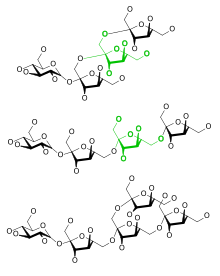Fructans
Fructans (also fructosans , Fruktosane , polyfructosans , polyfructoses ) is the name of a group of water-soluble oligo- and polysaccharides that in some plant taxa , the strength as a storage carbohydrate or supplement replace. Fructans are almost entirely made up of D- fructose units. Analogously, there is the substance group of galactans from galactose - monomers and glucans from glucose monomers.
structure
Fructans are characterized by the fact that one or more (many) fructose molecules are bound to a sucrose molecule .
Depending on the binding site of the fructosyl residue to the sucrose, a distinction is made between three basic types of fructan:
- 1- Kestoses : These are the components of inulin . The fructosyl residues are linked to the fructosyl residue of sucrose via β-2,1 bonds. The simplest representative is 1-kestotriose or isokestose.
- 6-kestoses: If the fructosyl residue is linked to the fructosyl residue of sucrose via a β-2,6 bond, one speaks of 6-kestotriose or kestose. Fructans of this type are sometimes referred to as laevans or phleines.
- Neokestoses : In neokestoses or 6G kestoses, the fructosyl residue is attached to the C6 of the glucosyl residue of sucrose.
However, pure homologous series of one type of linkage are rather rare. Especially with grasses, all three types of linkage often occur mixed, so that very complex branching patterns result.
Occurrence
Fructans occur in some groups of bacteria and are called levans here . Levan is characterized by a high degree of polymerization (over 100) and has β-2,6 bonds. The biosynthesis of the levans differs significantly from that of higher plants.
Fructans occur occasionally with some green algae ( Dasycladales , Cladophorales ) and mosses ( Sphagnales , Jungermanniales ). No fructans have yet been detected in ferns and gymnosperms .
Among the monocots ( monocots ) which have lily-like and asparagus-like fructans on Neokestosebasis that Süßgrasartigen ( Poales variety) and partly very complex Fructanmuster. In the dicotyledonous plants ( dicots ), fructans are found in the aster-like , rape-leaf plants ( Boraginaceae ) and card-like ( Dipsacales ). These are always fructans of the inulin type.
meaning
Some plants accumulate fructans during drought. This makes it easier to bear the drought. On the one hand, because the higher concentration of dissolved substances in the plant cell increases the osmotic potential and the water can be better absorbed by the plant. On the other hand, fructans should also protect cell membranes.
Since humans can only digest α-1,6 and α-1,4 linked oligo- and polysaccharides , fructans are suitable as sweeteners for diabetics .
Despite their molecular length (partly polysaccharides), fructans are assigned to the FODMAPs "fermentable oligo-, di- and monosaccharides and polyols". FODMAPs, in turn, play a role in functional bowel diseases such as irritable bowel syndrome (IBS), which is why reducing them in the diet can have a positive effect on the symptoms of functional bowel diseases. Numerous fructans (e.g. inulin) are also disadvantageous for irritable bowel patients, which is why they should be counted among the FODMAPs as an exception, which, however, is sometimes overlooked, to the disappointment of the patients.
In strong sunshine and low temperatures at the same time, the energy of grasses gained through solar radiation can not be converted directly into growth and is therefore temporarily stored in the form of fructans. This is especially the case on the first sunny days of spring and in late autumn. The resulting concentration of polysaccharides can lead to laminitis in horses .
literature
- Michio Suzuki, N. Jerry Chatterton (eds.): Science and Technology of Fructans . CRC Press, Boca Raton 1993, ISBN 0-8493-5111-1
- Horst Scheunemann: On the physiological behavior of fructans in the context of the carbohydrate balance of vegetative plant parts , Diss., Stuttgart 1993
Web links
- Basic fructan info ( Memento from February 21, 2003 in the Internet Archive )
Individual evidence
- ↑ MVZ Institute for Microecology GmbH: FODMAP-poor diet for irritable bowel patients. Retrieved June 3, 2020.
